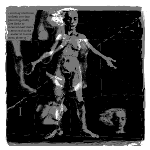
 |
Shelley Jackson Patchwork Girl or A Modern Monster and My Body: A Wunderkammer |
Certainly ranking among the most provocative of feminist hypertexts published so far, Shelley Jackson's Patchwork Girl (1995) makes readers want to talk back...if the growing body of critical writings is any indication. In this electronic novel, Jackson has created an intertext with Mary Shelley's Frankenstein and L.Frank Baum's Patchwork Girl that resonates with sheer exuberant excess. Intrinsically concerned with issues of monstrosity and femaleness, Jackson animates Mary Shelley's monster's never-born female mate. This was the mate that Victor Frankenstein refused to animate lest she prove to be more monstrous than his first attempt. But Jackson puts a spin on even the act of invention and interweaves the original Shelley in this novel as a player and a creator--of text and of monsters.
Toying with the open-ended conventions of the Gothic form, Mary's monster breaks out into the American world of popular culture, footnotes, marginalia, autobiography (perhaps?) and dialogue. This baby embodies everything that is deemed 'monstrous' in the female, including lesbian sexuality. Stitched together with theory, quotations and metatextual reflection, the Patchwork Girl speaks in the voices of the owners of her original body parts whilst one of the authors (by my count, there are three in total in the text) engages in conversation with the likes of Jacques Derrida. Jackson's novel is chilling, funny and unforgettable.
Her newer hypertext, a short kunstlerroman called My Body: A Wunderkammer, once again takes up issues of the female body and monstrosity, but this time in an adolescent girl. In an intriguing twist, the heroine deems her perfect, boyish figure freakish as are the changes her developing body undergoes, while her unusual attributes, like her piercings, her 28 tattoos, her phantom limb and her tail, are celebrated for their uniqueness. Organized around the controlling image of the curiosity cabinet (the 'wonderful room' of the title), the girl-body explores the fluid flow of memory through the associational links of its parts.
Shelley Jackson:
My Body: A Wunderkammer, 1997. Online.
URL: http://www.altx.com/thebody/.
Patchwork Girl, Eastgate Systems, 1995. Catalogue
URL: http://www.eastgate.com/catalog/Patchwork.html

Carolyn Guertin